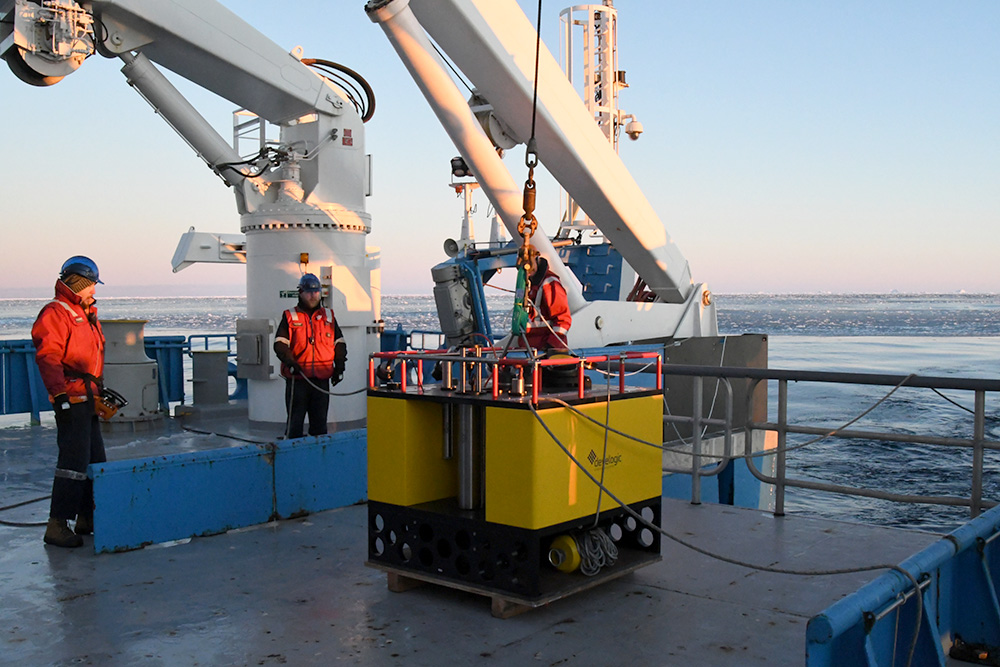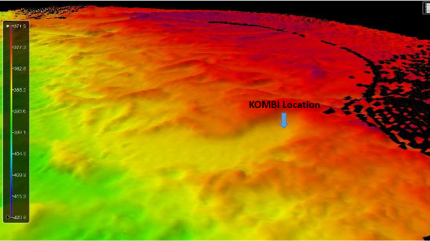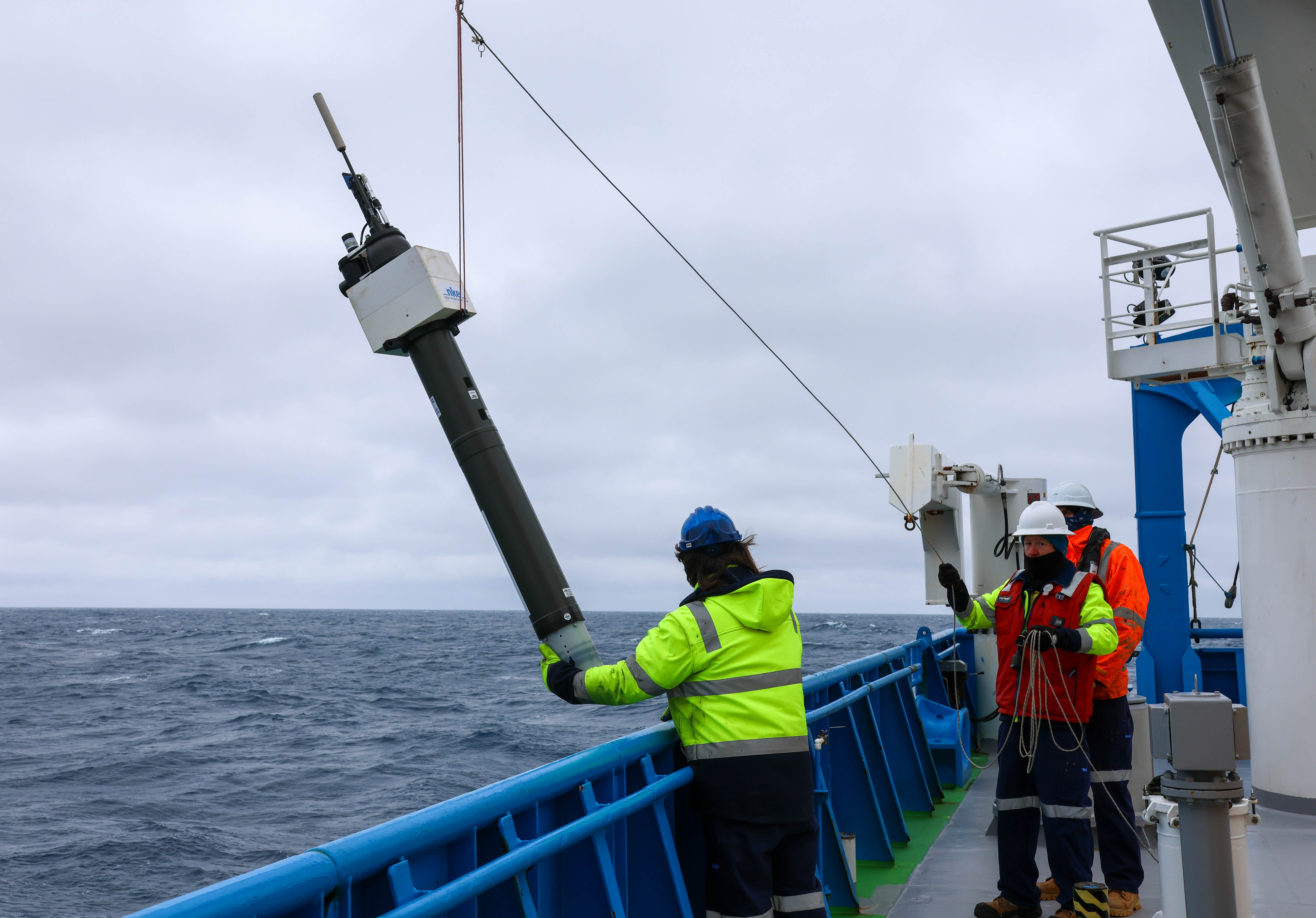Third and final KOMBI successfully deployed

Since Friday March 5, we have been working our way northward along Transect 5, but the bergy water forced us off our planned transect line and we had to manoeuvre around, but gradually we were able to make our way north. One of our major activities today was to find a suitable spot to deploy our third and final KOMBI.
Our target bottom depth was 350-400 metres, preferably between 370 to 380 metres. The reason for this is because the echosounder within the KOMBI can only monitor with sufficient accuracy, krill up to 400 metres above the KOMBI, therefore for it to be able to monitor the entire water column, the depth must be 400 metres or less. However, if it’s too shallow then there will be a high risk of the KOMBI being hit by the keels of grounding icebergs.

The chart indicated that in our preferred deployment area, the northern edge of the bank quickly drops deeper beyond the edge, so we switched on the bathy-multibeam system once we were above our target depth (380 metres) area to map and assess the bathymetry in detail. The area we first mapped was very flat with lots of scars carved by icebergs keels. We concluded that this well ploughed ground was not an ideal site, so we moved on and steamed farther north until we observed a rapid drop in bathymetry. We then turned the ship around and pursued detailed bathymetric mapping of the area. Around this area the bathymetry showed a steep drop at the northern edge of the bank but we also found a small pocket-like canyon structure on the western side of the area we mapped. Krill are generally thought to be likely to congregate at the edge of the continental slope and canyon structures, so we thought this was an ideal location for deploying a KOMBI to monitor krill dynamics over the next twelve months. One concern with this site was that there was at the time, a huge iceberg very close by, and we were not sure if the iceberg was grounded or not. If grounded, it might damage our KOMBI by slowly scraping the surrounding bottom over the next twelve months. Quick thinking by Gavin, our acoustics team leader, enabled the keel of the iceberg to be measured using the omni-directional sonar SH-90 which we usually use for detecting swarms of krill around the ship. By this means we confirmed that there was at least a 160 metre gap between the bottom of the iceberg and the sea floor. We also confirmed that the berg was very slowly moving away from the KOMBI site. This will be just the first of many icebergs that will pass by this site during the next year but based on all of this information we decided to go ahead with deploying the KOMBI at this location.
We shifted the vessel to the exact point and conducted a pre-KOMBI CTD with deep-sea camera and krill light trap, to be followed by the KOMBI deployment itself. All procedures were smoothly performed by the scientists, technicians and crew of the now well-oiled machine that is the survey team on RV Investigator. As we prepared for the moment of KOMBI deployment from the A frame on the rear deck, back in the CTD room, the light trap on the CTD was being opened. Jess and Maddie, the two night shift krillers, began screaming with joy! Yes, after 49 fruitless light trap deployments to the sea floor on this cruise, we had caught more than 150 krill in the fiftieth light trap deployment. This is the first time Krill have ever been captured in the light trap since we conceived, constructed and first deployed the light trap in 2011. The Deep-sea CTD camera also captured footage of the huge number of krill attracted to the light of the trap. The interesting thing is that there were no signs of krill in the water column from the acoustics, which suggest almost all krill were concentrated very closely to the bottom in this area at this time of the year. The thoroughness of our survey was paying off, as this localised site could easily have been missed if the number of CTD’s had been less. The KOMBI was then deployed and we are extremely excited that the KOMBI will be able to monitor krill dynamics for the entire water column at this location over the next 12 months, a fascinating prospect. At the time of writing this, the KOMBI will already have recorded nine minutes of video footage since it arrived at the sea floor.
We have now deployed all three KOMBIs. The first two were both deployed at 800 and 1500 metre depth at a location where we observed dense krill swarms at the surface near the ice edge. Today we deployed the last into a shallow canyon structure with high density sea floor krill. We cannot wait until next year’s KOMBI’s recovery from RSV Nuyina to unveil the as yet unknown lifestyle of krill during the long winter under the sea ice.
So & Rob



